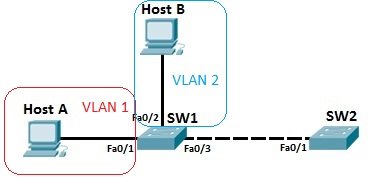To configure an interface to be an access interface, the switchport mode acess interface command is used. This type of interface can be assigned only to a single VLAN.
To configure a trunk interface, the switchport mode trunk interface command is used. This type of interface can carry traffic of multiple VLANs.
An example will help you understand the concept.
Host A and host B are in different VLANs, VLAN 1 and VLAN 2. These ports need to be configured as access ports and assigned to their respective VLANs by using the following sequence of commands:
SW1(config-if)# SW1(config-if)#interface fastEthernet 0/1 SW1(config-if)#switchport mode access SW1(config-if)#exit SW1(config)#vlan 2 SW1(config-vlan)#interface fastEthernet 0/2 SW1(config-if)#switchport mode access SW1(config-if)#switchport access vlan 2 SW1(config-if)#
Because the link between SW1 and SW2 needs to carry traffic of multiple VLANs, it needs to be configured as a trunk interface. This is done by using the following commands on both SW1 and SW2:
On SW1:
SW1(config)#interface fastEthernet 0/3 SW1(config-if)#switchport mode trunk
On SW2:
SW2(config)#interface fastEthernet 0/1 SW2(config-if)#switchport mode trunk
Now the link between SW1 and SW2 can carry traffic from both the VLAN1 and VLAN2. You can verify that an interface is indeed a trunk interface by using the show interface Fa0/3 switchport command on SW1:
SW1#show interfaces fastEthernet 0/3 switchport Name: Fa0/3 Switchport: Enabled Administrative Mode: dynamic auto Operational Mode: down Administrative Trunking Encapsulation: dot1q Operational Trunking Encapsulation: native Negotiation of Trunking: On Access Mode VLAN: 1 (default) Trunking Native Mode VLAN: 1 (default) Voice VLAN: none Administrative private-vlan host-association: none Administrative private-vlan mapping: none Administrative private-vlan trunk native VLAN: none Administrative private-vlan trunk encapsulation: dot1q Administrative private-vlan trunk normal VLANs: none Administrative private-vlan trunk private VLANs: none Operational private-vlan: none Trunking VLANs Enabled: All Pruning VLANs Enabled: 2-1001 Capture Mode Disabled Capture VLANs Allowed: ALL Protected: false Unknown unicast blocked: disabled Unknown multicast blocked: disabled Appliance trust: none SW1#
VLAN 1 doesn’t have to be created, it exists by default. Also, by default, all ports are in the VLAN 1, so Fa0/1 doesn’t need the switchport access vlan 1 command.
Download our Free CCNA Study Guide PDF for complete notes on all the CCNA 200-301 exam topics in one book.
We recommend the Cisco CCNA Gold Bootcamp as your main CCNA training course. It’s the highest rated Cisco course online with an average rating of 4.8 from over 30,000 public reviews and is the gold standard in CCNA training:

